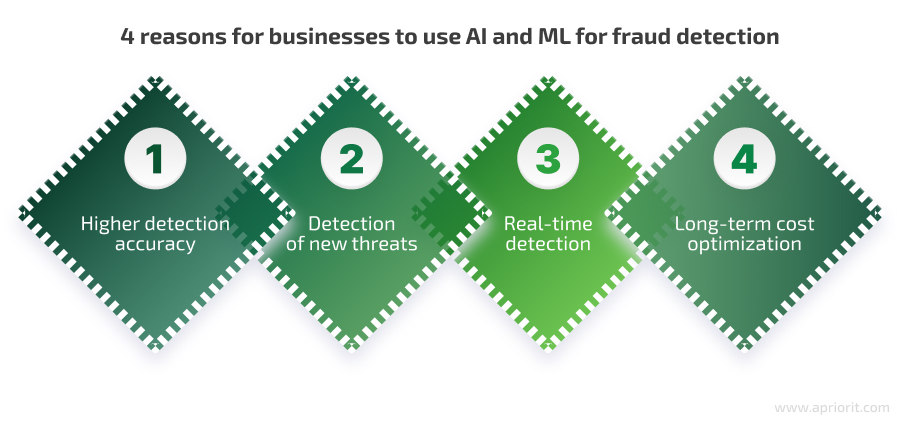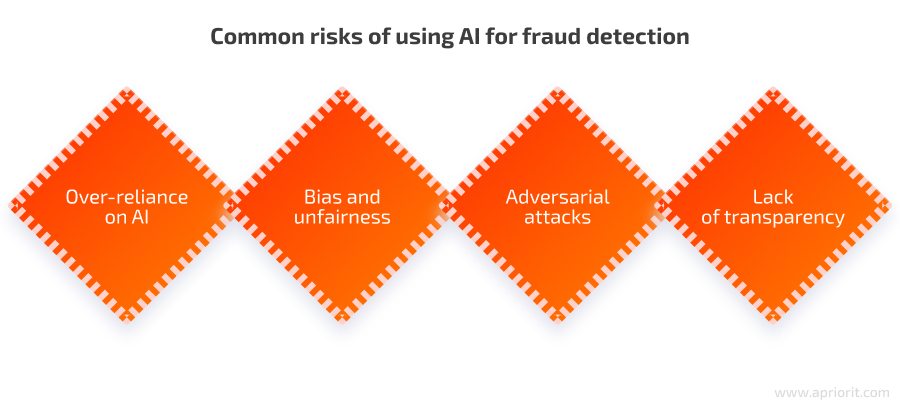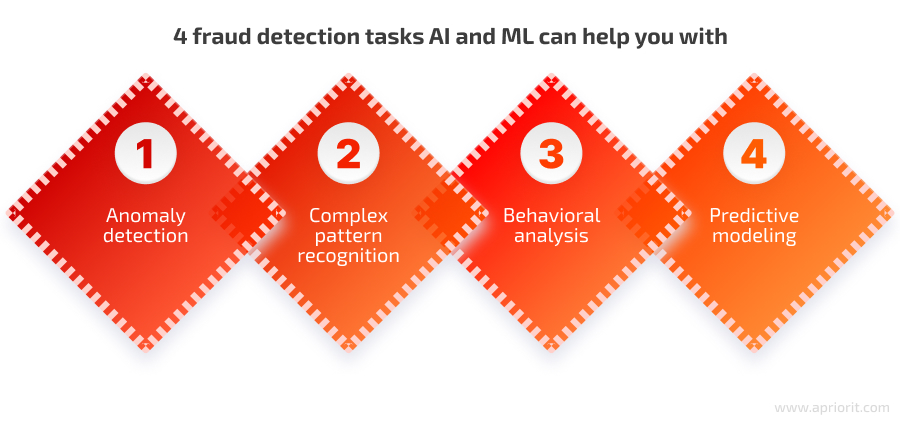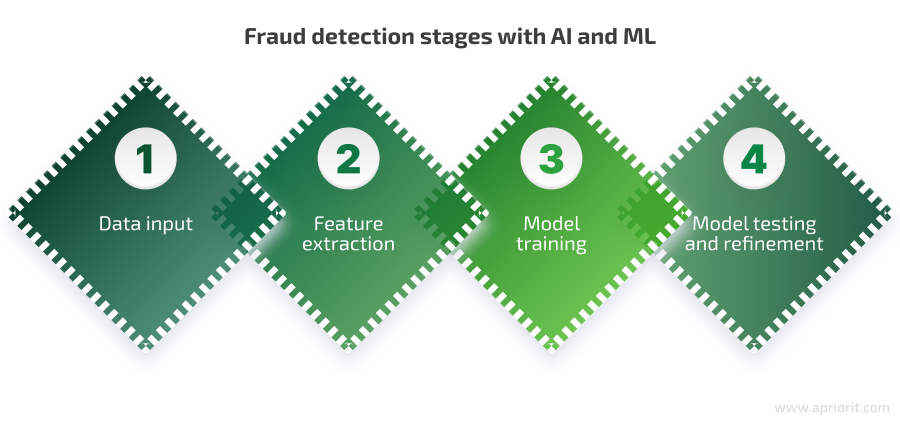Your business’s money and critical data are desirable targets for fraudsters and cybercriminals. To effectively secure your assets, you need to stay one step ahead and deploy anti-fraud solutions that can precisely detect suspicious activity in real time.
Where manual reviews and predefined rules can no longer bring the desired security for your critical assets, artificial intelligence (AI) and machine learning (ML) algorithms come into play. In this article, we discuss what industries can benefit the most from machine learning fraud detection and in what ways. We also cover common approaches and technologies to consider before designing your own AI model for fraud detection.
This article will be useful for technical leaders and product specialists who want to understand the capabilities and implementation options of AI and machine learning for fraud detection.
Enhancing fraud detection with AI
Fraud is on the rise across industries operating with large volumes of sensitive data and finances. Be it e-commerce or card operations, the number of fraud cases keeps growing from year to year. To prevent financial and reputational damage caused by cybercriminals, businesses invest heavily in fraud detection and prevention tools and mechanisms.
Fraud detection is a continuous process of monitoring and analysis that aims to identify and prevent the theft or misuse of valuable assets: usually sensitive data or money. Businesses and organizations operating in industries like finance, healthcare, and insurance widely use fraud detection tools and procedures to secure their assets, ensure regulatory compliance, and maintain customer trust.
There are several commonly used non-AI methods for detecting fraud:
- Manual review — Requires direct human intervention to investigate suspicious activity detected by other tools and systems. Can be time-consuming and thus less effective when immediate incident response is needed.
- Statistical analysis — Relies on mathematical algorithms and models to identify anomalies deviating from previously established patterns. These anomalies can then be flagged as potential fraud for further human review. While effective for detecting deviations from the norm, statistical analysis methods may be less helpful when it comes to detecting complex, non-linear forms of fraud.
- Rule-based systems — Detect fraudulent activity based on predefined rules and criteria. Usually, rules are based on known patterns and historical data related to previously detected cases of scams and theft. Such systems can be prone to a high level of false positives and require frequent updates to adapt to continuously changing human behavior. Rule-based systems also struggle to detect new types of cybercrimes.
It’s noteworthy that these methods can still be applied to specific cases, often in combination with AI-powered tools. For example, instead of blocking all suspicious users or actions automatically, an AI-powered system can flag them for further review by human experts. Such manual review can help prevent unfair treatment caused by bias in AI models and thus can and should be applied for evaluating complex cases.
Deploying and tailoring a statistical model or rule-based system may be more cost-efficient than building a custom AI model, especially for small businesses that don’t process extremely large volumes of data.
So, does your business need an AI-powered system to combat cybercriminals?
Want to enhance your product with AI?
Tell us about the capabilities you want to add to your software and let’s discuss how we can make them real!
Why use AI and ML for fraud detection?
By deploying AI fraud detection tools or adding an ML-powered feature to your software system, you can enable several critical benefits for your business:

1. Higher detection accuracy — AI-powered fraud detection solutions leverage advanced algorithms to analyze large volumes of data, thus reducing the number of false positives and ensuring more accurate detection of suspicious activities than traditional rule-based mechanisms and statistical analysis.
2. Detection of new threats — Machine learning algorithms can autonomously learn from new data and use it to determine legitimate and suspicious new patterns. This allows AI-powered systems to better adapt to evolving fraud tactics and stay ahead of emerging threats, whereas a rule-based system would require continuous rule updates.
3. Real-time detection — Fraud detection using machine learning can be performed on the go, with vast amounts of data being processed in real time. This enables businesses to promptly respond to potential scams, preventing or significantly minimizing both financial and reputational losses. Advanced AI solutions can also help prevent cybersecurity incidents, highlighting suspicious events or behaviors early on.
4. Long-term cost optimization — While using AI in fraud detection systems may be costly, incorporating such systems can help your business reduce cybersecurity expenses in the long run. In particular, with a strong and effective ML-powered fraud detection solution, you can optimize cybersecurity costs by conducting fewer manual reviews, dealing with fewer false positives, and shortening the time between occurrence and detection of fraudulent activity.
As you can see, AI-powered fraud detection tools can be more adaptable and accurate since they learn from data patterns and can adjust to emerging fraud schemes on the go. And, unlike traditional rule-based solutions, AI-powered systems can effectively detect complex fraud scenarios, reducing the level of false positives and improving the overall efficiency of your fraud detection efforts.
However, this promising technology has associated risks. Let’s take a closer look.
What are the risks of using AI for fraud detection?
While delegating fraud detection to AI systems has its benefits for businesses, it’s also associated with significant risks:

Over-reliance on AI — AI systems can help businesses reduce the level of required human intervention for assessing suspicious activity or incidents, freeing experts’ time for complex, strategic tasks. However, automating all of your fraud detection processes with AI may not be a good idea. Since even the best AI systems can still have both false positives and false negatives, it’s best to have a human expert validate complex cases and double-check the accuracy of your AI’s predictions before acting on them.
Bias and unfairness — AI-powered systems rely heavily on data and algorithms, both of which can be prone to the biases of their creators. Use of biased AI can lead to unfair treatment towards specific groups of people and be followed by lawsuits and loss of public trust, as happened to UnitedHealth Group in the US. To secure your business and your customers from such risks, make sure to use profoundly tested algorithms and well-balanced, diverse datasets.
Adversarial attacks — Cybercriminals can target your AI model, trying to manipulate input data and deceive the system. In order to prevent fraudsters from using your AI system against you, it’s important to adopt robust security measures, like validating data inputs, training your model on adversarial examples, and thoroughly testing and regularly updating your model.
Lack of transparency — When you work with so-called black box AI models, you may not be able to justify why a specific action or process is marked as fraudulent. To prevent trust issues with stakeholders, customers, and regulatory bodies, it’s important to rely on AI models whose operation is interpretable and transparent. For example, the World Health Organization outlines interpretability and transparency as key characteristics of AI systems that can be deployed in healthcare.
To effectively mitigate these risks, you need to understand how AI systems work and what technologies will be most suitable for your specific case. We’ll talk more about that later in the article. First, let’s see how you can use AI and ML to secure your business from fraud-related risks.
Read also
Biased Artificial Intelligence: Can Your AI Solution Be Freed from Built-in Prejudice?
Discover what your team can do to eliminate bias from your AI-powered product.
4 ways businesses can use AI and ML to detect fraud
How is AI used in fraud detection?
AI and ML can be used in various ways to discover and prevent various cybercrimes. Below, we outline the four most common tasks that you can tackle using AI and machine learning when looking for malicious activity:

1. Anomaly detection — You can use AI capabilities to identify anomalies in large datasets, spotting irregular patterns and behaviors that deviate from the norm. Such anomalies can indicate potentially fraudulent transactions, events, and activities.
2. Complex pattern recognition — AI models can be trained to recognize complex patterns that rule-based fraud detection systems can’t detect. Learning from historical data, machine learning algorithms can identify common fraud characteristics and adapt to new scam patterns.
3. Behavioral analysis — AI-powered solutions leveraging this technique establish a baseline of normal user activity and detect deviations from it, alerting you about suspicious actions that may require further investigation or an immediate response.
4. Predictive modeling — ML models can use historical data and evolving trends to forecast potentially fraudulent events. This forward-looking approach enables businesses to proactively address emerging threats and vulnerabilities, minimizing the impact of fraud incidents on their operations.
Depending on the industry you operate in, these tasks can get more specific and diverse. Let’s see some of the most common AI and fraud detection use cases and real-life examples across various industries.
Read also
Anomaly Detection on Social Media: How to Build an AI-Powered SaaS Platform with Python Tools
See if your business can benefit from detecting anomalies on social media and what AI tools to use for it.

Real-world examples of AI-powered fraud detection
AI systems must be trained using industry-specific fraud indicators, compliance requirements, and data characteristics. Below, we overview common fraud examples across five different industries and see how leading companies in those industries leverage AI and ML capabilities to secure their valuable assets from malicious actors.
Finance and banking
Fraud detection using AI in banking institutions and FinTech companies relies on analyzing transactional data and customer behavior. It allows for detecting cases of money laundering, card fraud, account takeover, and other types of financial deception. In the US alone, fraud-related losses for FinTech companies are estimated to be as high as $51 million per year.
Searching for a solution to the problem of financial fraud, many banking and finance organizations deploy AI-powered tools.
For example, Coinbase has an ERC-20 Scam Token Detection System that can detect scams by combining predictions made by machine learning algorithms and audits of smart contracts.
Mastercard uses AI to help banks identify and stop potentially fraudulent payments before funds even leave a victim’s account.
Insurance
Nearly 60% of insurance companies already apply AI for fraud detection. Using vast amounts of historical data related to insurance claims, AI models learn to identify false insurance claims, staged accidents, and exaggerated damage.
One example of an insurance provider leveraging an AI-powered fraud detection system is Shift Technology. The company uses AI to analyze claim data to detect potentially fraudulent insurance requests.
French insurer AXA also uses AI to detect fraudulent claims. Their AI algorithms analyze data from both received claims and external sources, like insurance policy data, searching for anomalies that can signal fraudulent activity.
Healthcare
Healthcare providers have to deal with different types of fraud, from false insurance claims to billing and prescription fraud. Due to the high sensitivity of the data healthcare providers and pharmaceutical companies work with, such solutions often require applying stronger data anonymization mechanisms or using synthetic data for training AI models.
Optum Labs uses a custom AI-powered system to detect improper billing, suspicious behavior, and fraudulent activities. In particular, their system can flag suspicious claims based on factors like billing irregularities, unusual diagnoses, and provider behavior.
E-commerce
Similarly to financial organizations, e-commerce platforms use AI to analyze user behavior, account activity, and transactions to detect potential fraud. With the help of dedicated AI models, they can identify potentially dangerous events such as account takeovers or fraudulent transactions.
PayPal uses AI and ML to enhance their payment authorization system by detecting and preventing fraudulent transactions. Global merchants like Amazon and Shopify also use AI algorithms to detect fake reviews and fraudulent transactions.
Gaming and entertainment
Gaming and entertainment services use AI-powered tools to detect cheating and fraudulent in-game transactions, detect bots, and prevent unauthorized account access and takeover. Analyzing user behavior, gameplay patterns, and transaction histories, machine learning models identify anomalies that can be related to scam activities.
PUBG uses AI models to identify and block accounts used for cheating. Netflix has a custom framework that streaming services can use to detect content fraud, account fraud, and account abuse.
Now that you know what you can do with AI in terms of fraud detection, let’s take a closer look at the inside mechanisms of an AI-based fraud detection product.
Related project
Building an AI-based Healthcare Solution
Creating a highly precise model for detecting and measuring follicles helped our client increase diagnosis accuracy and provide better patient care.
How AI and ML models detect fraud
To understand how machine learning algorithms determine which instances are fraudulent and which are not, let’s take a look at a basic process of fraud detection with machine learning:

1. Data input — To deliver a truly efficient solution, you need to aggregate enough training data, paying special attention to its relevance and quality. This is why in some cases, you might need to build and pre-process a fully custom dataset, spending extra resources on allocating large volumes of data, filtering out irrelevant pieces, and labeling the remaining data to effectively train your model.
Having a well-balanced, unbiased dataset is important for ensuring your model’s efficiency,
fairness, and transparency. For highly regulated industries like healthcare and finance, you’ll also need to invest in strong data anonymization mechanisms to meet corresponding data security requirements.
2. Feature extraction — Make sure to identify and extract features from your dataset. Your model needs those features to create meaningful and relevant inputs that it can use to learn how to distinguish suspicious transactions, detect identity theft, and so on.
Usually, AI systems analyze a combination of factors like geolocation, devices and operating systems, and chosen payment methods. The more complex your system is supposed to be, the wider the diversity of features it must be able to extract from original data in order to identify and analyze fraud.
3. Model training — Machine learning algorithms are usually trained on labeled data to learn various patterns and relationships between extracted features. To improve the efficiency of your model’s training, it’s important to keep your data as representative and diverse as possible. To do so, you can:
- Eliminate redundant and irrelevant data points to ensure a balanced representation of different fraud scenarios
- Expand your dataset using techniques like data augmentation, especially if you’re dealing with unique and rare fraud types
- Employ cross-validation methods to increase your model’s reliability
- Regularly reassess and update your dataset to reflect new types of fraud
4. Model testing and refinement — The ready model should be tested on a dataset different from the one it was trained on. Based on testing results and user feedback, you should continuously update your model and adjust its parameters to make sure that your model stays fair and provides accurate predictions even when presented with previously unknown data.
How to implement an AI model for fraud detection
Depending on your business objectives, budget constraints, and the urgency of implementation, you can go with different approaches to building your AI-powered fraud detection solution.
Common approaches to implementing AI for fraud detection
When you decide to start a new AI project and leverage this technology for identifying suspicious activity or events, you can choose from three approaches:
1. Use a ready solution — Some ready services and software products offer AI capabilities for detecting anomalies, scams, and fraud. Using a ready solution will work for businesses dealing with typical types of malicious activity.
On the downside, off-the-shelf solutions usually rely on black-box AI and offer strictly limited customizability. This makes them poorly scalable and sometimes not secure enough to be used in highly regulated industries like finance and healthcare unless the models were initially tailored to specific use cases. An off-the-shelf product also might not work best for businesses that need full control over their software and data.
Before adopting an off-the-shelf solution, conduct a comprehensive assessment to check its compatibility with your current systems and data formats. It’s also advisable to review the vendor’s update policy and customer support services to ensure the solution will keep up with evolving fraud tactics.
For businesses in highly regulated industries, verify that the solution meets all necessary compliance requirements.
2. Customize a pre-trained model — Pre-trained models can work as a template for your future solution, allowing you to save both time and money on building a custom product. In contrast to using ready-made products, customizing a pre-trained model gives you more control over your AI model’s scalability, security, and performance.
The obvious drawback is that your development team will first need to find a model that can be fine-tuned to your specific case, which can be a challenge. Also, you may need to enhance your team with expertise to ensure efficient customization and seamless integration of the finalized model with your existing systems.
Start by identifying models that have been successful in similar use cases or industries. Once a suitable pre-trained model is chosen, invest in detailed analysis of its architecture and training data to understand its strengths and limitations.
Ensure that your data science team has the necessary expertise, or consider partnering with external experts for the customization process. Additionally, conduct rigorous testing to validate the model’s performance on your specific data sets before full deployment.
3. Build a custom model from scratch — The more unique your use case, the higher the chance that you might need to build a brand-new AI model from scratch. With the unlimited flexibility of custom development, you can account for industry-specific regulations, market trends, and unusual customer requests all within a single solution.
Building and training such a highly personalized solution can be costly, however, as it requires a lot of time and rare AI development skills.
Begin with a clear definition of your unique fraud detection requirements and constraints. Engage a team with strong expertise in AI and your business’s specific domain. Given the resource-intensive nature of this approach, ensure that you have a feasible plan for data collection, model development, and continuous testing.
Keep in mind the model’s scalability and future adaptability. Post-deployment, establish a framework for ongoing evaluation and refinement of the model to adapt to new fraud patterns and data.
No matter which approach you decide to go with, make sure to plan for regular updates of your model, continuous monitoring of its performance, and adaptation to new fraud trends. Additionally, consider the ethical implications of and biases in AI models, ensuring that your solution is fair and doesn’t inadvertently discriminate against certain user groups.
At Apriorit, we help our clients optimize their project expenses by customizing and fine-tuning suitable pre-trained models so they can get the first results in a short time and with limited investments. For projects that require thinking outside the box, we suggest unusual implementation strategies and help build fully custom AI algorithms and models.
Next, let’s discuss what pre-trained models and libraries your team can consider when working on a fraud detection system.
Pre-trained models and Python libraries for fraud detection
To speed up development of an AI-based fraud detection solution, your team can use pre-trained models fed with specific types of data to perform a limited set of tasks.
Depending on the type of fraud detection tasks you have at hand, you can use:
- Classification models, particularly ML classifiers like random forests, can distinguish fraudulent activities from legitimate ones.
- Anomaly detection models can help you detect deviations from the established norm. Common examples include autoencoders, one-class support vector machines, and isolation forest models.
- NLP models can be used to detect fraud based on textual data, such as chatbot logs and emails. Examples of models you can use include generative AI models like Bidirectional Encoder Representations from Transformers (BERT) and Generative Pre-trained Transformer (GPT).
When looking for a pre-trained model for your fraud detection project, pay attention to factors like the model’s domain relevance, performance, and customization capabilities as well as the fairness of used algorithms. Also, it’s important to check if the model of your choice is properly secured from adversarial attacks and unauthorized access.
Next, let’s go over some of the libraries your development team can find useful when working on a fraud detection AI system. The choice of particular libraries will depend on the data and algorithms you want to use in your fraud detection system. Since most AI solutions rely on Python, we’ll cover some of the Python libraries commonly used for fraud detection:
- Scikit-learn provides tools for data preprocessing and feature selection, as well as various algorithms for classification and anomaly detection.
- TensorFlow can be used to find patterns in normal data and identify anomalies. It’s often used in tandem with PyTorch.
- PyTorch leverages pre-trained autoencoders to recognize normal data and detect anomalies when the model encounters data deviating from learned patterns.
- Imbalanced-learn was originally designed to address class imbalance in machine learning tasks. However, you can use this library to handle skewed datasets common in fraud detection scenarios.
- Pandas can help you extract relevant features, preprocess data, and prepare the dataset for training your model to detect anomalies.
- XGBoost allows for training a classification model to learn normal patterns and identify anomalies that deviate from them.
To choose the right technology stack and development approach for your AI-based fraud detection product, you need to account for multiple factors, from your industry and relevant regulatory requirements to the diversity of scams you want your system to be able to detect. If completing such a complex task seems to be a challenge for your in-house team, you can outsource the development and maintenance of your AI fraud detection product to Apriorit.
Read also
Can You Rely on GPT-3 in AI Development Projects?
Get actionable advice on how to fine-tune GPT-3 to better handle your project’s tasks.

Conclusion
While detecting complex fraud incidents on the go can be a challenge for a human analyst, AI-powered systems can assist human experts in accurately identifying malicious activity in real time. Businesses in various industries, from finance to healthcare and gaming, deploy AI-powered tools and functionalities to validate transactions, prevent identity theft, and block cheating accounts.
Machine learning algorithms can be prone to bias and need to be trained and tested on diverse and balanced datasets. To increase the fairness of your AI model, it’s also important to refrain from absolute automation of your fraud detection activities and have human experts evaluate controversial cases.
To build an efficient fraud detection solution, it’s important to form an expert team and choose the technologies and development approaches that best suit your project. With Apriorit, you can enhance your in-house team with rare AI and cybersecurity talents or delegate the full development process to a dedicated team of seasoned experts. Our business analysts, software engineers, and quality assurance specialists will gladly assist you at any stage of your project, from market analysis to AI model refinement.
Are you planning a new AI project?
Our experts can help you enhance your product with the necessary cybersecurity and fraud detection capabilities.




